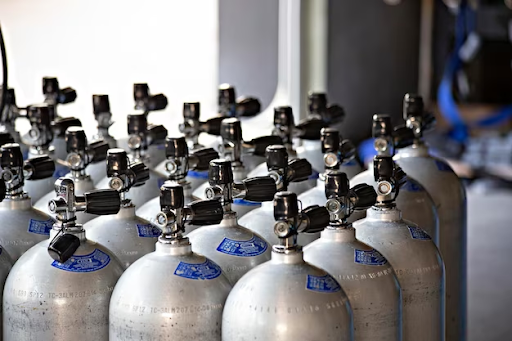In a medical emergency, every second counts. That’s why having access to medical oxygen cylinders can be lifesaving. Whether you’re a healthcare professional, caretaker, or concerned individual, this comprehensive guide will equip you with all the essential information you need to know about medical oxygen cylinders.
With expert advice and practical tips, we’ll help you confidently navigate the world of medical oxygen cylinders. Stay prepared and empowered with the knowledge to handle medical emergencies effectively. Read on to unlock the vital information about medical oxygen cylinders that could one day save a life.
Understanding Medical Oxygen
Medical oxygen is a critical component of emergency medical care. It treats patients with respiratory conditions, such as chronic obstructive pulmonary disease (COPD), asthma, and pneumonia. Oxygen therapy helps increase the oxygen levels in the blood, which is essential for the normal functioning of the body’s organs and tissues.
When it comes to obtaining medical oxygen cylinders, the process is essential for ensuring patient care. Medical oxygen is typically delivered through portable oxygen cylinders. These cylinders contain compressed oxygen that can be administered to patients through a nasal cannula, face mask, or other delivery devices. The oxygen flow rate and delivery method depend on the patient’s condition and the healthcare provider’s recommendation.
For those in the healthcare industry, knowing where to buy medical oxygen cylinders is crucial. Medical oxygen cylinders are available in various sizes, from small portable cylinders to large stationary ones. The size of the cylinder determines the amount of oxygen it can hold. Understanding the different types of medical oxygen cylinders is important to ensure the appropriate selection for specific medical needs. So, the decision of where to buy medical oxygen cylinders should be made carefully to meet the needs of both healthcare providers and patients.
Types of Medical Oxygen Cylinders
- Compressed Gas Oxygen Cylinders: These cylinders contain oxygen in a compressed gas form. They are made of steel or aluminium and are commonly used in healthcare facilities and ambulances. Compressed gas cylinders are available in different sizes, such as D, E, M, and H cylinders, each with varying capacities. These cylinders are refillable and require regular inspections to ensure safety and compliance with regulations.
- Liquid Oxygen Systems: Liquid oxygen systems consist of a stationary reservoir filled with liquid oxygen and a portable unit for dispensing the oxygen to the patient. The liquid oxygen is stored at extremely low temperatures (-183 degrees Celsius) and is converted to gas before being inhaled by the patient. Liquid oxygen systems are commonly used by patients who require a high flow rate of oxygen or those with limited mobility.
- Oxygen Concentrators: Unlike compressed gas cylinders and liquid oxygen systems, oxygen concentrators do not store oxygen. Instead, they extract oxygen from the surrounding air and deliver it to the patient. Oxygen concentrators are portable devices that are powered by electricity. They are often used by patients who require long-term oxygen therapy at home. Oxygen concentrators provide a continuous oxygen supply and eliminate the need for refilling or replacing cylinders.
Handling and Storage
Proper handling and storage of medical oxygen cylinders are crucial to ensure the safety of both patients and healthcare providers. Here are some important guidelines to follow:
- Transportation: When transporting medical oxygen cylinders, securing them in an upright position is essential to prevent them from falling or tipping over. Cylinders should be properly secured in a vehicle, preferably with straps or brackets designed for this purpose. Avoid exposing the cylinders to extreme temperatures or direct sunlight during transportation.
- Storage: Medical oxygen cylinders should be stored in a well-ventilated area away from flammable materials and heat sources. Keeping the cylinders upright and secure is important to prevent them from falling or being knocked over. The storage area should be clean, dry, and free from oil, grease, or combustible substances.
- Handling: When handling medical oxygen cylinders, it is crucial to follow proper safety precautions. Always use gloves and safety glasses to protect yourself from potential hazards. Do not drop or strike the cylinders, which can damage the valves and cause leaks. If a cylinder is damaged or leaking, it should be removed from service immediately and replaced with a new one.
Regulations and Compliance
Various national and international standards regulate the use of medical oxygen cylinders to ensure safe and effective use. It is important to comply with these regulations to prevent accidents and ensure the quality of medical oxygen delivery. Here are some key regulations to be aware of:
- Cylinder Inspection: Medical oxygen cylinders must undergo periodic inspections to ensure their safety and integrity. These inspections are typically conducted by qualified technicians who check for any signs of damage, corrosion, or leakage. Cylinders that fail the inspection should be taken out of service and replaced.
- Labelling and Markings: Medical oxygen cylinders should be properly labelled and marked to indicate their contents and other important information. The labels should be clear and legible, with information such as the cylinder’s capacity, date of last inspection, and the name of the company responsible for its maintenance.
- Storage and Handling: Regulations often specify guidelines for storing and handling medical oxygen cylinders. These guidelines may include securing the cylinders, maintaining proper ventilation, and keeping them away from flammable materials. Compliance with these regulations is essential to prevent accidents and ensure the safety of patients and healthcare providers.
Conclusion
Medical oxygen cylinders play a vital role in emergency medical care. Understanding the different types of cylinders, proper handling and storage, compliance with regulations, and troubleshooting techniques are essential for effective and safe use.
By familiarising yourself with the information provided in this guide, you can be better prepared to handle medical emergencies and potentially save lives. Stay empowered with the knowledge and confidence to handle medical oxygen cylinders, and remember to always seek professional help when needed. Invest in your knowledge today so you can be a lifesaver tomorrow.
